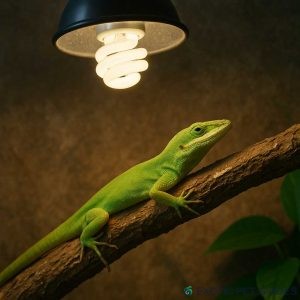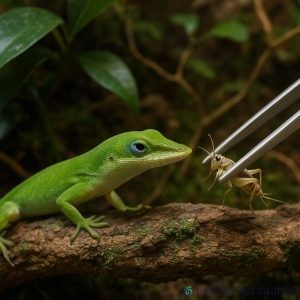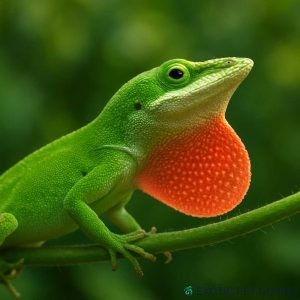🧭 Introduction
Green Anoles (Anolis carolinensis) are one of the most popular beginner reptiles. These small, active lizards are native to the southeastern United States and are known for their:
- Bright green or brown coloration
- Ability to change color based on mood or temperature
- Unique throat fan (dewlap) displays
They’re fun to watch, relatively easy to care for, and perfect for observation-focused keepers.

📐 Enclosure Basics
Ideal Tank Size
- Single Anole: 10–15 gallons (tall tank preferred)
- Pair/Group: 20–30 gallons minimum
- Vertical space is crucial for climbing and basking.
Enclosure Orientation
Use a tall glass terrarium with:
- Climbing branches
- Live or fake plants
- Background foliage for hiding

🌡️ Temperature, Lighting & Humidity
Green Anoles need a warm, humid, and well-lit habitat to thrive.
Temperature
| Zone | Temperature |
|---|---|
| Basking spot | 85–90°F (29–32°C) |
| Ambient daytime | 75–80°F (24–27°C) |
| Nighttime drop | 65–72°F (18–22°C) |
- Use a basking bulb and digital thermometers to monitor heat zones.
UVB Lighting
- Essential for calcium metabolism
- Use 5.0 UVB tube (Zoo Med or Arcadia recommended)
- Light cycle: 12 hours on / 12 hours off

Humidity
- Target range: 60%–70%
- Mist 1–2x daily
- Provide water droplets on leaves — anoles rarely drink from bowls
🥬 Feeding Guide
Green Anoles are insectivores and prefer live prey.
Staple Insects:
- Crickets (gut-loaded)
- Small dubia roaches
- Flightless fruit flies (for juveniles)
- Black soldier fly larvae
Feeding Schedule:
| Age | Frequency |
|---|---|
| Juveniles | Daily |
| Adults | Every 1–2 days |
Dust prey with calcium powder (2–3x/week) and multivitamins (1x/week).

🧤 Handling Tips
Green Anoles are delicate and fast, and handling can cause stress.
Safe Handling Guidelines:
- Avoid daily handling
- Let them walk onto your hand
- Handle close to the ground to avoid injury if they jump
- Don’t grab from above — they see this as predatory
🧠 With time, some anoles become comfortable with short, calm interactions.
🩺 Health & Behavior
Signs of Good Health:
- Active during the day
- Eats regularly
- Vibrant green/brown color depending on mood
- Regular shedding
Watch Out For:
- Sunken eyes (dehydration)
- Lethargy or weak grip
- Constant dark brown color (stress)
- Refusing food

✅ Pros & Cons for Beginners
Pros
✔ Small and inexpensive to care for
✔ Fun to observe and photograph
✔ Easily available in pet stores
Cons
✘ Fragile and easily stressed
✘ Not ideal for frequent handling
✘ Needs daily misting and humidity control